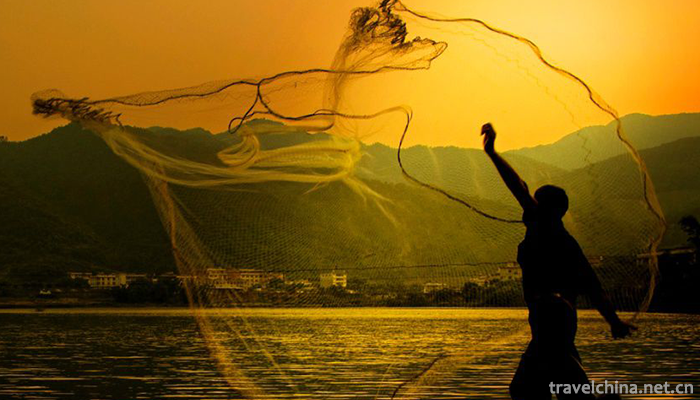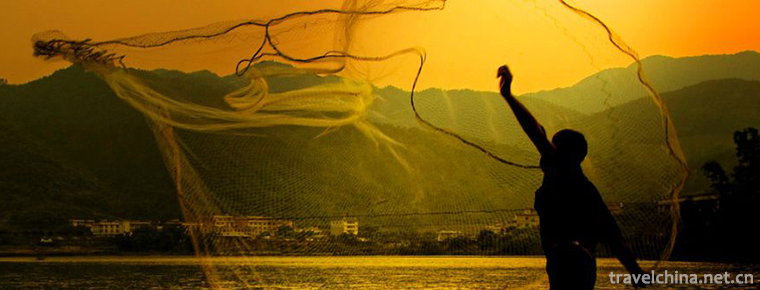Fishing Song
Fishing Song
Fishing songs are a kind of Chinese folk songs sung by fishermen in coastal areas of China and lakes and harbours. If popular in Shanwei City, Guangdong Province, collectively known as Shanwei Fishing Songs, and in Huidong, Guangdong Province, there are also fishing songs, belonging to the same kind of Shanwei City. It can be divided into deep sea and shallow sea. The former is sung by deep-sea fishermen, similar to saltwater songs, while the latter is sung by seaside fishermen and women. Usually refers to shallow water fishing songs.
On December 03, 2014, the fishing songs (Dongting Fishing Song and Shanwei Fishing Song) were listed in the fourth batch of national intangible cultural heritage list with the approval of the State Council.
artistic characteristics
Fishermen sing songs and answer each other. —— Song Fan Zhongyan's Records of Yueyang Towers
It is also called "Fisherman's Instruction". Fishermen sing folk tunes. Tang Wang Bo's "Preface to the Banquet on the Upper Sifu River" said: "All the banners are quoted together, and the fishing songs are intertwined." Xu Zhenqing's poem "Send Geng and Hui to Keep Huzhou" in the Ming Dynasty: "Maizhu frequent Laotian officials drums, fishing songs near the king's boat." Qin Huitian's poem "Yanziji" in Qing Dynasty: "Shadows of sails hang in the shadows, fishing in the twilight."
The Lyric format is generally seven-character sentences, two sentences and one song, with four or eight sentences and one song. Four sentences also start with five-character or three-character sentences. The last three words of the second or fourth sentence are often repeated with a complement or a whole sentence. The interlining words are distinctive and often used to distinguish the names of different tunes, such as "Ha-ha-xiang tune" and "Li-li tune". The tunes are lively and beautiful, such as the Guangdong Haifeng Fishing Song "Welcoming the Flower Boat to the Fishing Village". Another example is the fishing song popular in Poyang Lake, Jiangxi Province, which is sung by fishermen. The lyrics are mostly seven-character sentences, four sentences and one paragraph. The tune is mainly in the form of levying tunes. It is broad and melodious, such as the song "A net of fish and shrimp, a net of grain".


-
1.Wuhou Temple in Chengdu
Martial Marquis Memorial Temple,Chegdu city,Sichuan Province
Time 2018-09-29 -
3.Zhashlenbu Temple Scenic Spot in Shigaze
Zashrunbu Temple means "auspicious Xumi Temple". Its full name is "Zashrunbu Baijid Qinqu Tangkelenan Bajawalin". It means "auspicious must gather in Fushu to win over Fangzho
Time 2018-12-12 -
4.Central Radio and Television Tower
The Central Radio and Television Tower, now a national 4A scenic spot, is located on the west side of West Third Ring Road, Haidian District, Beijing. Near the Space Bridge, it faces beautiful Yuyuant
Time 2018-12-22 -
5.The Great Northern Wilderness Agricultural Expo
Beidahuang Agricultural Machinery Expo Park is a national AAAA-level tourist attraction located in Youyi County, 50 kilometers away from the city center, covering an area of 350,000 square meters.
Time 2018-12-26 -
6.Kunlun Mountains
Kunlun Mountain, formerly known as Kunlunqiu, also known as Kunlunxu, is the god mountain in ancient Chinese legend, the ancestor of Wanshan Mountain, the birthplace of Chinese civilization, and the k
Time 2019-01-29 -
7.Linqu canal
Lingqu, formerly known as the Qin Digging Canal, Zero Canal, Douhe Canal, Xing'an Canal and Xianggui Canal, is a great project created by the working people of ancient China
Time 2019-01-30 -
8.Niulang and Zhinu Scenic Spot
Niulang Zhinu Scenic Area is located in Yanya Town, southeast of Yiyuan County, Shandong Province, 15 kilometers away from the county town. The scenic area is mainly composed of Daxianshan Mountain
Time 2019-02-07 -
9.Mongolian Humai
Humai, also known as laryngeal singing, double singing, multi-voice singing or Haolinchao, is a singing method of many ethnic groups around Altai Mountains, not unique to the Mongolian people.
Time 2019-06-03 -
10.Miao Batik Dyeing Techniques
Batik dyeing is one of the ancient folk traditional printing and dyeing techniques of the Chinese nation. As early as the Qin and Han Dynasties, the Miao people had mastered batik dyeing techniques, a
Time 2019-06-05 -
11.Nu Fairy Festival
Fairy Festival is a traditional folk festival of Nu people in Gongshan area of Yunnan Province. The local flower festival, also known as the Flower Festival, is held on March 15 of the lunar calendar
Time 2019-06-08 -
12.Calculation with an abacus
Liu Hong (129-210 A.D.), a character Zhuo, a descendant of Liu Xing, the king of Lu in the Eastern Han Dynasty, is an outstanding astronomer and mathematician in ancient China. He is the inventor of a
Time 2019-08-10